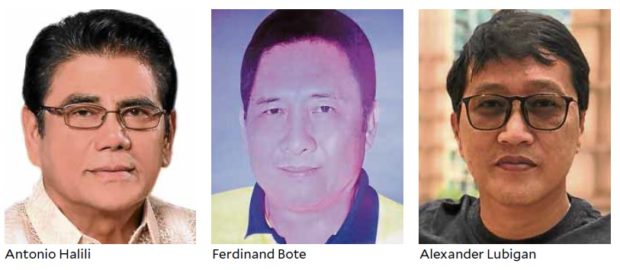
“No. Impossible. No way. No way that lives will be sacrificed just so the President can impose martial law nationwide,” said Sen. Aquilino Pimentel III, one of President Rodrigo Duterte’s staunchest allies.
“We are not like that and the President is not like that. Let us not believe that kind of analysis. That analysis is too politically intriguing,” said Pimentel, president of the administration party, Partido Demokratiko Pilipino-Lakas ng Bayan.
Two mayors and a vice mayor were gunned down in separate attacks last week.
On July 2, Tanauan City Mayor Antonio Halili was killed during a flag-raising ceremony at City Hall in Batangas province.
The next day, General Tinio Mayor Ferdinand Bote was killed by gunmen as he was leaving the National Irrigation Administration compound in Cabanatuan City.
Climate of fear
On Saturday, Vice Mayor Alexander Lubigan, of Trece Martires City in Cavite province, and his driver died after they were attacked by armed men.
The Liberal Party warned last week that the series of killings of local officials could have been orchestrated to create a climate of fear that would give the administration the basis for martial law.
Senate President Vicente Sotto III said: “The atmosphere doesn’t call for it. These incidents of local infighting are not new. We’ve had them for a long time, even during and after martial law.”
In a briefing on Monday, presidential spokesperson Harry Roque said: “Martial law is only for rebellion or invasion … So even if there are a number of killings and there was no rebellion or invasion, there is no reason to impose martial law.”
He echoed the police finding that there was no system or pattern behind the killings of Halili, Bote and Lubigan.
“So I think the more plausible explanation behind this is it’s really the political season in the Philippines,” Roque said.
Philippine National Police Director General Oscar Albayalde said: “The only common denominator we see is that they are elected officials, and that is, I think, coincidental.”
Two-week monitoring
Police said those behind the killing of Halili could have been watching the mayor’s movements at least two weeks before the attack.
Investigators from the Calabarzon (Cavite, Laguna, Batangas, Rizal, Quezon) police on Monday said two Toyota Innova cars were seen at Loyola Gardens cemetery near the supposed position of Halili’s shooter.
The vehicles’ plates, police said, turned out to be fake.
Supt. Chitadel Gaoiran, regional police spokesperson, said the cars were seen coming in and out of the cemetery around the same time in the morning on June 18 and June 25, the two Mondays before Halili was killed.
Police were also tracking down the black pickup truck, a Toyota Hilux, that the gunmen in the killing of Lubigan used.
Police said security cameras showed the vehicle traveling toward the towns of Indang and Naic, both in Cavite, after Lubigan was attacked on July 7.
Senior Supt. William Segun, Cavite police director, also said investigators were tracing communication records from the mobile phones of Lubigan’s driver, Romulo Guillemer, who died in the attack, and security aide, Romeo Edrinal.
Chief Supt. Edward Carranza, Calabarzon police director, said police were looking primarily at politics as motive for the attack, especially after Lubigan expressed his intention to run for mayor in 2019. —REPORTS FROM DJ YAP, CHRISTINE O. AVENDAÑO, JAYMEE T. GAMIL, MARICAR CINCO AND ANDREA ALCARAZ